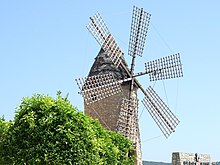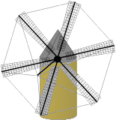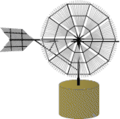Windmills in Mallorca
Windmills on Mallorca have a long tradition. In the past they were considered an important part of Mallorcan agriculture and still characterize the landscape of the Spanish Balearic island today .
With the exception of the Greek Mediterranean island of Crete , nowhere else in the world are there so many windmills in one area as on Mallorca. However, their distribution on the island is quite different. Many of the mills are in a state of disrepair, some, most of which characterize the townscape, have been restored.
history
The origin of the Mallorcan windmills is disputed. The Persians are said to have developed windmills and spread them in the Mediterranean as early as the 7th century. After that, the Arabs took over the practical construction of this type of mill and brought it to the Iberian Peninsula as part of the expansion of Islam towards the west . It is believed that even before the Christian conquest of the island in 1229, there were windmills on Mallorca.
The first evidence of flour mills on Mallorca comes from the 14th century. There were more than 50 mills in the El Molinar district alone . The windmills, in which olive oil was pressed and grain ground, experienced their heyday in the 17th and 18th centuries. El Molinar is still known today as a fishing village at the gates of Palma. A long line of mills once stood here, which gave this village its name.
At that time there were around 1,000 of these mills scattered all over the island. Most of the surviving specimens, however, date from the 19th century and were used as wind pumps to bring groundwater to the surface in order to irrigate the fields.
The oldest water mill was built in 1845 and is still in the plain of Sant Jordi near the airport of Palma . Well-preserved mills can also be found in Sa Pobla , Muro and Campos . Although the windmills have lost their original importance for agriculture , they are an integral part of the cultural heritage of the Balearic island. Around 3,300 of these structures are still on Mallorca.
The windmills still shape the landscape of the island's plains today. Charles William Wood , member of the Royal Geographical Society , described the Mallorcan windmills in his "Letters from Mallorca" in 1888 as follows: "The strange windmills of Mallorca ... they have six blades instead of four, which makes them look strange and unfamiliar." And further: "In addition, the sails with their ropes and ropes resemble the complicated and intricate rigging of a ship."
Only a fraction of the approximately 2,500 water extraction mills is still in use today. The wings of the older grain and salt mills, which were used until the 20th century, stand completely still with the exception of one.
function
The energy used for windmills is the kinetic energy of moving air masses in the earth's atmosphere , which is created by contrasts in air pressure as a result of temperature fluctuations and the rotation of the earth. This is sometimes called wind . It is therefore also an indirect form of solar energy and is one of the renewable energies . The use of wind energy by a windmill is one of the oldest ways of drawing energy from the environment and was already widespread in ancient times .
Technically speaking, a windmill is a device that uses the kinetic energy contained in the wind as mechanical force. For this purpose, windmills take the energy with their wings from the wind and convert it into rotational energy . To do this, the blades must be turned into the wind so that it hits the blades from the front and sets them in motion. The rotational energy obtained in this way is fed into the mill building via a vane shaft.
Locations in Mallorca
| Municipal area: | Water pumps * | Grain mills * | Number per location |
| Alaró | 3 | 3 | 6th |
| Alcúdia | 8th | 11 | 19th |
| Algaida | 13 | 24 | 37 |
| Andratx | 4th | 15th | 19th |
| Ariany | 1 | 6th | 7th |
| Artà | 2 | 23 | 25th |
| Binissalem | 2 | 7th | 9 |
| Citizen | 10 | 10 | 20th |
| Calvià | 6th | 6th | 12 |
| Campanet | 8th | 7th | 15th |
| Campos | 629 | 31 | 660 |
| Capdepera | 3 | 19th | 22nd |
| Consell | 0 | 2 | 2 |
| Costitx | 0 | 5 | 5 |
| Esporles | 0 | 1 | 1 |
| Felanitx | 5 | 76 | 81 |
| Inca | 2 | 13 | 15th |
| Lloret de Vistalegre | 2 | 6th | 8th |
| Lloseta | 1 | 1 | 2 |
| Llubí | 3 | 9 | 12 |
| Llucmajor | 21st | 85 | 106 |
| Manacor | 10 | 58 | 68 |
| Maria de la Salut | 0 | 6th | 6th |
| Marratxí | 16 | 9 | 25th |
| Montuïri | 3 | 24 | 27 |
| Muro | 183 | 10 | 193 |
| Palma | 1,112 | 72 | 1,184 |
| Petra | 4th | 20th | 24 |
| Pollença | 1 | 5 | 6th |
| Porreres | 3 | 40 | 43 |
| Puigpunyent | 1 | 5 | 6th |
| Sa Pobla | 298 | 13 | 311 |
| Sant Joan | 2 | 14th | 16 |
| Sant Llorenç | 10 | 20th | 30th |
| Santa Eugènia | 0 | 5 | 5 |
| Santa Margalida | 6th | 19th | 25th |
| Santa Maria | 7th | 7th | 14th |
| Santanyí | 10 | 38 | 48 |
| Selva | 2 | 5 | 7th |
| Sencelles | 9 | 11 | 20th |
| Ses Salines | 92 | 7th | 99 |
| Sineu | 5 | 19th | 24 |
| He shall | 0 | 1 | 1 |
| Son Servera | 12 | 16 | 28 |
| Valldemosa | 0 | 5 | 5 |
| Vilafranca de Bonany | 3 | 7th | 10 |
| Number: | 2,512 | 796 | 3,308 total |
* As of 2003 Source: FODESMA
Windmill types by design
Grain Mills
Flour Mill A
(Spanish name: Typo Molino Harinero - Torre Ancha) - Windmill with a wide round tower, built from Marès limestone and field stones.
Built: in the 14th and 15th centuries.
Use: Grain, salt mill.
Distribution area: All of Mallorca
Flour mill B
(Spanish name: Typo Molino Harinero - Velas Latinas) - windmill with Latin rigging (sail pole blades)
- Built: in the 18th century
- Use: grain
- Distribution area: municipality of Selva
Flour mill C
(Spanish name: Typo Molino Harinero - Torre Estrecha) - flour mill with a slim round tower
- Built: in the 19th century
- Use: grain and salt
- Distribution area: in particular Ses Salines and the entire island of Mallorca
Windmills for pumping water
Pump mill A
(Spanish name: Extractor de Agua Antiguo) - Pump-mill with Latin rigging, slender round tower made of Marès and field stones
- Built: 1847
- Use: pumping water, draining wetlands
- Distribution area: Pla de Sant Jordi (near Airport Palma de Mallorca)
Pump mill B
(Spanish name: Molino de Ramell) - mill with wooden wing lamellas, the appearance - ram de flors ("bouquet of flowers") - gave this design its name, round tower or square construction made of Marès and field stones
- Built: 1854 by Damián Reixach
- Use: water pump, groundwater pumping
- Distribution area: Palma , St. Jordi, Campos and Ses Salines
- Molino de Ramell
at sa Casa Blanca (Palma)
Pump mill B1
(Spanish name: Molino de Ramell Grande) - mill with wooden wing lamellas, the appearance - ram de flors ("bouquet of flowers") - also gave this design its name, whereby the bouquet was much more lush than in version B and therefore good even in light winds Brought conveyance. In addition, this variant was also built with a wind control. Round tower or square construction made of marés and field stones
- Built: around 1880
- Use: water pump, groundwater pumping
- Distribution area: Mainly Palma , Muro , Sa Pobla and Campos
Pump mill C
Spanish name: Molino de Ferro (Ferro = Hierro in Catalán) - impeller iron construction with sheet metal wings, tower square construction made of Marès blocks .
The wind turbines of the 20th century in the plain around the airport of Palma, which were mainly used to irrigate the fields and drain the marshland, are almost a symbol. They usually have a horizontal axis and up to 18 very simple curved sheet metal leaves. The rotor follows the changing wind direction via a wind vane. The rotary movement is converted into an up and down movement of a pump piston rod . In this way it is possible to pump water to the surface from a depth of up to 35 m.
The power of the wheels was 1 - 25 kW. Due to the large number of blades, the turbines also ran in low winds. However, the rotor turns relatively slowly. The rotation speed of the blade tips corresponded roughly to the wind speed.
- Built: from 1934 based on the American design of the Molino Americano see special shapes
- Use: water pumps, groundwater pumping, irrigation of agricultural areas
- Distribution area: all of Mallorca
Special forms
In the case of the American-style wind turbines for pumping water (Spanish name: Aerobombas Estilo Americano) on lattice mast constructions, the lifting rod to the feed pump moves in the middle of the mast. The pumps mostly also worked according to the plunger pump principle .
The American wind turbine , which was widely distributed on farms in the United States at the beginning of the twentieth century, is located in smaller installations. They have a different number of blades and an automatic brake control that turns the wheel out of the current in strong winds.
- Built: from 1920 (import mills from USA and mainland Spain)
- Use: Water pumping deep wells / groundwater (Spanish usage name: Extracción de Agua)
- Distribution area: Original first versions near Palma. more modern wind turbines later all over Mallorca
conservation
In 1993 the Government of the Balearic Islands founded the school FODESMA. The aim is to train young people in construction and restoration in the tradition of windmill construction. FODESMA has set up its workshops in the halls of the old Son Bonet airfield and since it was founded, 73 windmills have been overhauled and brought back into operation.
See also
Individual evidence
- ↑ Translation in part from: www.conselldemallorca.net
- ^ Translation from the Catalan text of the book: L'AIGUA, EL VENT, LA SANG, Edicions Documenta Balear, Idioma: Catalán, ISBN 84-604-6425-3
- ↑ FODESMA archive link ( Memento from September 10, 2007 in the Internet Archive )
literature
- MOLINOS Y NORIAS by Vicente M. Roselló Verger, Published in 1959 by Panorama Balear Idioma: Castellano
- L'AIGUA, EL VENT, LA SANG, l'Us de les Forces Tradicional a Mallorca por Nicolau S. Cañellas, Edicions Documenta Balear, Idioma: Catalán, ISBN 84-604-6425-3
- MAN AND THE WINDMILLS Balearic Islands, por Alejandro García Llinás, Idioma: Original en Catalán. Traducido al Inglés y Alemán, ISBN 84-930748-0-2
- Friedrich Kettenbach: The miller and mill builder. Practical manual for millers, mill builders and technical educational institutions, Vol. 1 and 2, Leipzig 1907/1908
Web links
- Windmills on Mallorca (German)
- Molins de Vent de Mallorca (Catalan, Castilian, English)
- Molins de Mallorca ( Memento from September 12, 2011 in the Internet Archive ) (English)

















